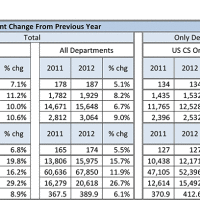Taulbee in Depth: Department Space per Faculty Member
Every three years, the CRA Taulbee Survey asks a set of Department Profiles questions including questions about department space. In the full Taulbee report published in CRN in May 2013, we reported on the space data collected in fall 2012. Tables in that report provided percentiles for department space in the categories of total space, offices, conference and seminar rooms, research labs, and instructional labs. The percentiles were across all departments of a given type (US CS Public, US CS Private, US CE, US Information, and Canadian) without regard for the size of the department. However, department size is clearly a major determiner of space. To allow departments to better compare their own space allocations to the overall Taulbee numbers, this analysis reports on space per faculty member in two ways: by number of tenured and tenure-track faculty, and by number of tenured and tenure-track faculty plus number of research faculty and postdocs. Those values were computed for each department; percentiles of the normalized space for all US departments and for each type of department are given in tables.








